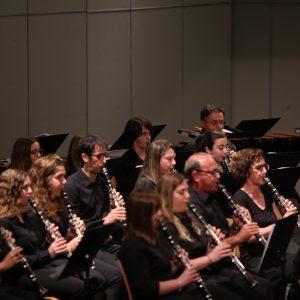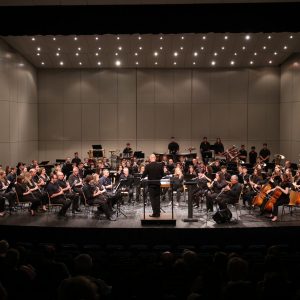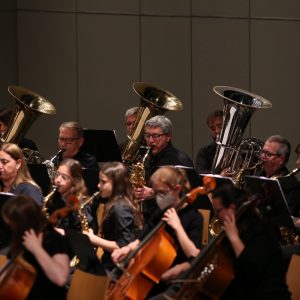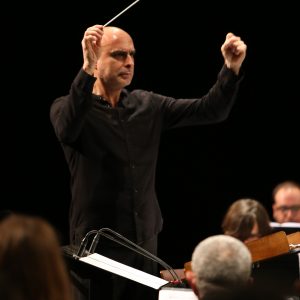Special concert of SFA Symphonic Band
PROGRAMME
Symphonic Band of Societat Filharmònica Alteanense
Lagartijilla (4’15”)
(pasdoble)
by J. M. Martín
Smphony for Winds
by Martin Ellerby
-I Tribute (6’5”)
-II Chorale (7’45”)
-III Display (4’5”)
Simfonia núm. 2 “de la Mar” (20’15”)
by Martínez Gallego
Director: Rafael M. Garrigós García
Notes of the programme
Special concert by the Symphonic Band of the ‘Societat Filharmònica Alteanense’, in which they announce to their audience their participation in the First Section of the City of Valencia International Music Band Contest 2023, next 07/15/2023, and presents in this concert the free and compulsory work with which the band will participate in the Contest. [Text by ‘Google Translate’]
SYMPHONIC BAND OF SOCIETAT FILHARMÒNICA ALTEANENSE
The origins of the Sociedad Filarmónica Alteanense go back to 1889, when a music band
was created on an afternoon of 25th of August when it performed its first concert, conducted by Maestro Francisco V. Marzal Ferrer (Almoines). On the 1st of August de 1915, twenty-six years later, it officially became the Sociedad Filarmónica Alteanense, presided by Doctor José Sevila Sánchez and impulsed by music teacher Maestro José Pérez Albiñana.
One hundred and twenty-five years history of a band which has obtained over thirty prizes and awards. Worthy of mention are the awards obtained at the Frankfurt International
Competition (1973), at the World Music Contest WMC Kerkrade (Holland),two Gold medals in 1985 and two Gold Medals, Mention of Honour and Banner of Honour in 1989, the Alicante Regional Council Competition (1986 and 1988), the Valencian Community Competition (1986),and the City of Valencia International Competition (1987 and 1990). It was awarded the Agrupaciones Musicales Cultura Viva National Prize in 1992 “ for its great interpretive quality, reflected in its important international success”.
Its most recent award is the Gold Medal with Mention of Honour obtained at the 15th World Music Contest WMC Kerkrade (Holland) in 2005. A great many honours and awards occupy the display cabinets, among them the Importantes Prize of the Información newspaper’s 2000 November editions. It was awarded the Euterpe Prize in 2004, the
maximum prize awarded by the Federation of Music Societies of the Valencian Comunity.
José María Martín Domingo (1889–1961) was a Spanish composer and musician. He was born in Mahón on 23 May 1887 and died in Madrid on 16 July 1961.
Domingo’s father, Cecil Martin, was a military musician stationed in the regimental band of Menorca island. There, Jose Maria he began learning music theory at age five. At nine he entered San Bernardo boarding school in Madrid where he met the Master José Chacón (musician), who cared for the young student and continued with his training, recommending him to the tutelage of the trumpet professor, Tomas Coronel, at the Royal Conservatory. Emilio Vega, director of the Alabarderos band, educated him in the disciplines of counterpoint, fugue and composition.
At fourteen Domingo obtained a place as first musician in the Cazadores de Barbastro Battalion, stationed in Madrid. The following year he joined the Alabarderos Royal Corps Band.
He quickly acquired a reputation as a virtuoso and was frequently invited to the orchestras in the zarzuela and opera theaters.
Thomas Coronel introduced him to the Royal Theatre Orchestra, whose director, Ricardo Villa, on creating the Madrid Municipal Band, in 1909 granted him the position of first trumpet at the age of 22.
Master Villa, recognized Martin Domingo as a great Director and, in the absence of Miguel Yuste-Vice director, Jose Maria began to take the baton.
Martin Domingo began to form his own groups, which he directed in the San Isidro, Atocha and Hotel Nacional cafes, meeting and cultural centers of Madrid. He began to be famed not only as a director but also as a composer. He opened many pasodobles, polkas, waltzes, habaneras, mazurkas, etc… which were highly successful and popular.
In 1918 he managed to become an Army Major musician, stationed in Santa Cruz de Tenerife. There he directed public concerts with the military band, organized choirs, composed works such as the celebrated Ven, Cyrilla, Icod, pasodoble on canary grounds, El Desfile, El Coronel Mayorga, among others. At the request of Master Villa, he requested a transfer to the peninsula.
After Miguel Yuste died he left the army, becoming Vice director of the Madrid Municipal Band, where he served for over 30 years. He combined this with his work as composer, being the author of works such as Lagartijilla, Marcial, eres el más grande (dedicated to Marcial Lalanda) and Los Dos Adolfos.
He became friends with contemporary literature and art personages such as Carlos Arniches, Francisco de Cossio, Jacinto Guerrero, Federico Moreno Torroba, Mariano Benlliure and others.
In 1953 the Madrid City Council awarded him the Silver Medal of the City. Years before, the French Republic awarded him the city of Paris medal.
COMPULSORY PIECE: «SYMPHONY FOR WINDS»
Symphony for Winds is cast in three movements exploiting the wide range of colours and dynamics available within the contemporary wind ensemble.
1. Tribute: Two highly contrasting moods, one rhythmic and aggressive, the other calm and relaxed; yet both in the same tempo, compete with each other to dominate the opening movement. The first subject is always in search of a theme, realised at the conclusion, whereas the second always has one, but extends and develops i ton each reappearance.
2. Chorale: A series of chorales in a simple, direct idiom provides an aura of calm between the outer, more aggressive movements. Instrumental colour, soft dynamics and much use of tuned percussion and celesta are paramount.
3. Display: The finale is a highly charged, dynamic scherzo contrasting tuttis with more subtle combinations of solo instruments. Based on the principles of scales and arpeggios, though adapted, melody is always endeavouring to be part of the chase. This is tather like a miniature “concerto for orchestra”.
BIOGRAPHY MARTIN ELLERBY
Martin Ellerby was born in Worksop, England in 1957. After graduating from the London College of Music he studied composition with Joseph Horovitz and counterpoint with W. S. Lloyd Webber at the Royal College of Music, and with Wilfred Josephs.
He has written several sinfonias and concertante works, music for strings, several instrumental sonatas and suites, songs and choral music including a Mass for choir and orchestra. He has also written pieces for brass band and for concert band.
Amongst his awards and citations are the W. S. Lloyd Webber Director’s Prize, the Westminster Prize, the Arts Council of Great Britain Dio Fund Award, an Allcard Award, the George Butterworth and Norman Sykes Memorial Fund Awards, the Freedom of the City of London, the Royal Military School of Music 2008 Dr. Martin Ellerby Class, the 2012 BUMA International Brass Award (Holland), and, in his 60th birthday year (2017), the John Henry Iles Medal of the Worshipful Company of Musicians.
He holds a Doctor of Musical Arts Degree (DMA) from the University of Salford, an Honorary Doctor of Letters Degree (Hon DLitt) from the University of West London and five fellowships. He is the Artistic Director for Studio Music Company (London), External Examiner to the Royal Air Force Music Services (RAF Northolt) and Honorary Principal of the Victoria College of Music Examinations Board.
Work composed commissioned by the Villa de Altea International Music Band Contest to the composer Martínez Gallego for the 2019 edition of the contest. This edition was dedicated to the designation of Altea as “Valencian Cultural Capital”, under the motto “MAR DE CULTURES”.
As a whole, the work is structured in 3 movements which are interpreted continuously.
Outside of any idea about descriptive music, the 1st Movement represents the ancient Altea, the archaic Altea which was nourished during its history of different cultures. Rhythmic movement with a thematic material from a Popular Song of this people, ‘Sierra Molinet’.
The first notes of another popular melody, ‘Mariner’, appear as a link between some sections of the entire work.
The 2nd Movement represents the ‘Sea’ and the monument which looks straight ahead, the Church of ‘Our Lady of Consuelo’.
The B theme, dedicated to the Church, draws on some pages of the Renaissance composer Carlo Gesualdo, a composer who was ahead of his time, with an original, strange and surprising work in the Renaissance, especially for his concept of ‘Chromatism’.
This chromatism will also be a fundamental part of the 3rd Movement of the Symphony.
With a new theme, original by the author, and in contrast to the 1st, this last movement represents the current and modern Altea. The link with the first part of the work is the use of some new and peculiar variations on this subject.
The work, in its entirety, draws on a modal language, some of the modes built by the author himself.
Francisco Martinez Gallego
[Text by ‘Google Translate’]
Born in San Antonio de Requena (Valencia). He began his musical studies at the School of Music of the Musical Society “La Armónica” of San Antonio, later going to the Conservatories of Murcia, Torrente and Valencia, this center where he obtained the Superior Clarinet Title.
However, the field in which he will see himself fully realized will be in that of composition. He will expand his training in this area with the Jazz teacher and composer Daniel Flors, with Miguel Ángel Matéu and Teo Aparicio Barberán.
Subsequently, he finished the Higher Degree in Composition at the Superior Conservatory of Castellón. In this new stage he studies with professors, among whom it is worth highlighting, such as Ferrer Ferrán, César Cano, Miguel Ángel Berbis, Claudia Montero, Jesús Vizcaino and Emilio Calandín.
Starting in 1998, he began to be interested in conducting a band, expanding his studies with different teachers, including José Rafael Pascual Vilaplana. His main activity as a director, at present, is focused on the S.M. “El Arte” from Sinarcas (Valencia), with which he recently obtained First Prize and Honorable Mention in the 39th Edition of the Provincial Contest of Valencia and First Prize and Honorable Mention in the 37th Edition of the Valencian Community Band Contest.
Among multiple 1sts. Awards, 2nd. Awards and Accésits stand out:
• 1st. Prize in the I Altea National Festive Music Competition, year 2000.
• 1st. Prize in the II Calpe Festive Music Composition Contest, year 2002.
• 1st. Symphonic Music Composition Award for Finestrat Band, 2005.
• 1st. Prize in the Pasodobles Composition Contest of Sant Joan de Moró, year 2009.
• 1st. Prize of the V Composition Contest ‘Vila de Muro 2015’, year 2015.
In November 2014 he traveled to the US where his Symphony no. 1 ‘Kaprekar’ by the Illinois State University Wind Symphony.
Several of his compositions for his band are performed as required and free works in various competitions.
He is a member of the SGAE (General Society of Authors and Publishers), of COSICOVA (Association of Valencian Symphonic Composers) and of ACMMIC (Association of Moors and Christians Music Composers).
He is currently a professor of Harmony, Analysis and Fundamentals of Composition at the ‘Mestre Molins’ Professional Conservatory of Music in Quart de Poblet (Valencia).
[Text by ‘Google Translate’]
Rafael M. Garrigós García (1966, Enguera-Valencia). He began his musical studies at the school of the band Unión Musical Santa Cecilia de Enguera. Later he carried out musical studies in the superior conservatories of Valencia, Madrid, Granada, Murcia, in the specialties of Horn, Piano, Harmony, Counterpoint and Fugue, Composition, Orchestra Direction and Choir Direction. He has obtained an Extraordinary Prize in the specialty of Choir Direction and in Composition and Instrumentation. Parallel to his musical studies, he has completed university studies in Pedagogy.
He has been principal conductor of the following groups: Orchestra and Choir of the Professional Conservatory of Music of Jaén, Youth Orchestra of the Professional Conservatory of Music of Alicante, Choral Group of Benidorm, Crevillent Choir of Crevillent, Band of Music “La Primitiva” of the Association d’amics de la Música de Callosa d’en Sarriá, Symphonic Band and Chamber Orchestra of the Altean Philharmonic Society, and Symphonic Band of the Musical Society “La Alianza” of Mutxamel (Alicante). He is currently the principal conductor of the Unión Musical de Canyada (Alicante) band, and of the Symphonic Band of the Unión Musical de Agost Philharmonic Society. With these groups he has made concert tours in Portugal, France and Italy.
Currently he also works as musical director with the “Compañía Lírica Andaluza”, with which he performs zarzuela performances such as “agua, azucarillos y aguardiente”, “la revoltosa”, “la gran vía”, or “la boda de Luis Alonso”.
As a guest he has conducted, among others, the Municipal Symphonic Band of Alicante, Symphonic Band of the Musical Society “La Primitiva Setabense” of Xativa, Unión Musical de Ibi Band, Youth Band of Santa Maria da Feira (Portugal), Symphonic Band of the Musical Society “La Nueva” of Xátiva, Orchestra of the Superior Conservatory of Music of Castellón, Banda Unión Musical Santa Cecilia de Enguera, Municipal Band of Jaén, Banda Societat Musical l’Harmonia de Alacant, Orchestra of the Andalusian Lyric Company.
In his role as composer, works for orchestra, choir, band and chamber groups have been premiered in Alicante, Valencia, Castellón, Murcia, Andalusia, etc. He has also composed various works of an educational nature that have been part of the programs of study of conservatories such as the one in Valencia, Castellón and Alicante. Some of his works have been programmed on RNE, Channel 9, Radio LP and RAI (Italian Radio Television) and are published by the AB Música publishing house in Valencia.
He has been part of the jury of composition and interpretation competitions such as the Callosa d’en Sarriá Festival Music Composition Contest 2007 and 2008, Mutxamel Pasodobles Composition Contest 2007, Final Phase of the 8th Vinalopó Regional Instrumental Performance Contest 2008 , VII Contest of Festival Music Bands of Altea la Vella 2009, among others.
Since 1991 he has belonged to the Body of Music and Performing Arts Teachers of the State, and since 1999 he has been a professor at the Professional Conservatory of Music of Alicante, teaching the subjects of Musical Language, Musical Informatics and Complementary Piano.






